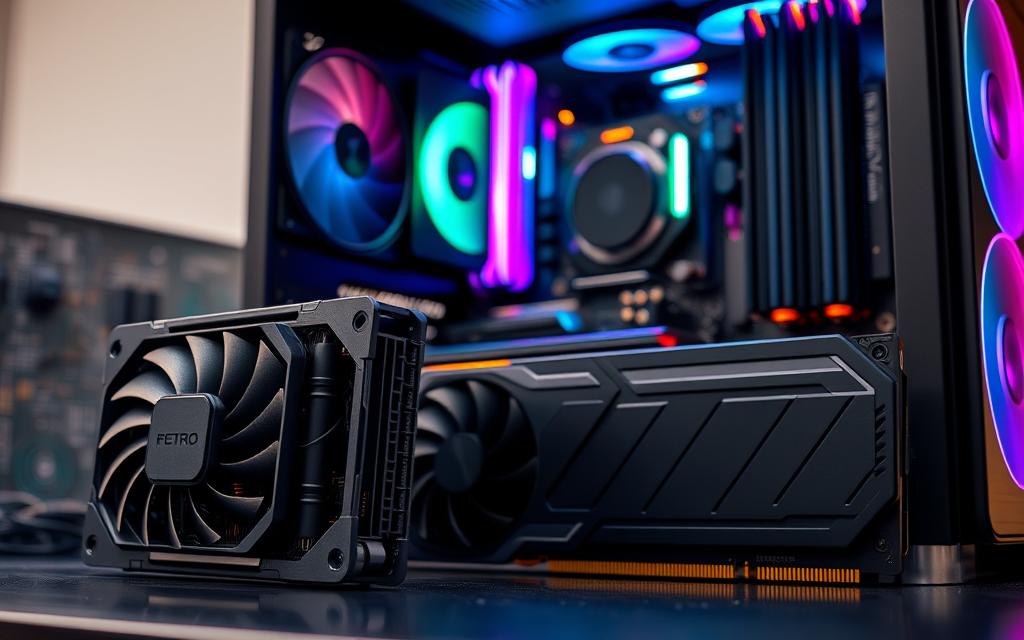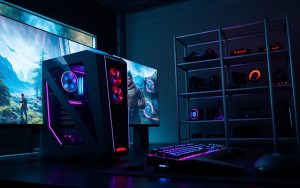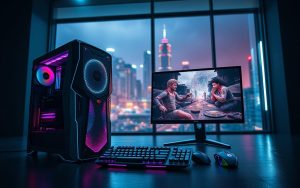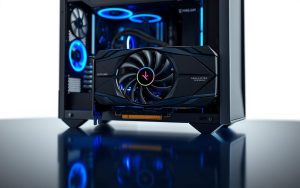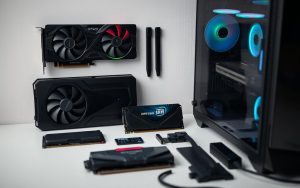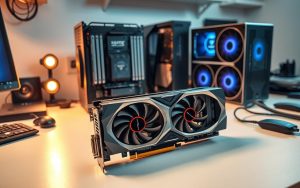Table of Contents
A powerful gaming rig requires more than just flashy lights. The right components determine smooth gameplay and long-term value. Unlike standard computers, these systems prioritize raw performance.
Key elements like the GPU and CPU work together for seamless visuals. Fast RAM and SSD storage reduce load times. Balancing these parts ensures no bottlenecks during intense sessions.
Mid-range builds often hit the sweet spot between cost and capability. Investing in upgradable parts extends your system’s lifespan. For expert insights, explore top-tier gaming PCs that master this balance.
Introduction to Gaming PCs
Modern gaming demands hardware that pushes the boundaries of performance and creativity. From basic setups to high-end rigs, computers have evolved to meet the needs of today’s players. Dedicated GPUs and powerful processors are now essential for handling demanding titles like Cyberpunk 2077.
The rise of 4K gaming and eSports has redefined expectations. Gamers now seek systems that deliver smooth visuals and lightning-fast responses. Unlike consoles, gaming PCs offer unmatched flexibility, including modding capabilities and upgradability.
Portable alternatives like the Steam Deck have also entered the scene, catering to those who want gaming on the go. However, traditional rigs remain the go-to choice for serious players. They provide a balance of power and versatility, making them ideal for both work and play setups.
“Gaming PCs are more than just machines; they’re gateways to immersive worlds.”
Whether you’re a casual player or a competitive eSports enthusiast, the right setup can elevate your experience. Investing in quality components ensures your system stays relevant in the ever-changing gaming world.
What Makes a PC Good for Gaming?
The foundation of an exceptional gaming experience lies in selecting the right hardware. A well-balanced system ensures smooth gameplay and prevents bottlenecks. Five critical components define a high-performance setup: the graphics card, CPU, RAM, storage, and cooling system.
Modern titles demand a powerful graphics card like the RTX 40-series for stunning visuals. Pair it with a robust CPU to handle complex calculations. At least 16GB of RAM ensures multitasking without lag. Fast storage, such as an SSD, reduces load times significantly.
Balancing these parts is crucial. For example, PC International’s build featuring an i7 processor, RTX 3080, and 16GB RAM demonstrates optimal performance. This setup avoids bottlenecks, ensuring every component works harmoniously.
Game resolution also impacts hardware requirements. While 1080p gaming is less demanding, 4K gaming requires top-tier components. Additionally, optimizing your system for Windows 11 can enhance performance and compatibility.
- Graphics Card: Handles rendering and visual effects.
- CPU: Manages game logic and physics.
- RAM: Ensures smooth multitasking.
- Storage: Reduces load times with SSDs.
- Cooling: Maintains optimal temperatures.
Investing in quality parts ensures your system stays relevant for years. Whether you’re gaming at 1080p or 4K, the right combination of components delivers an immersive experience.
The Importance of a Powerful Processor (CPU)
The processor is the brain of any gaming setup, driving performance and efficiency. It handles everything from physics calculations to AI processing, ensuring smooth gameplay. Without a robust CPU, even the best graphics card can’t deliver its full potential.
Modern games demand high power to manage complex tasks. A faster CPU reduces lag and improves frame rates. It also ensures compatibility with other components, like RAM and GPUs, for a balanced system.
Why the CPU Matters in Gaming
The CPU’s role extends beyond basic processing. It manages in-game physics, AI behavior, and multitasking. For example, open-world games like Cyberpunk 2077 rely heavily on the processor for seamless exploration and interaction.
Core count is another critical factor. While 4-core CPUs suffice for casual gaming, 6-8 cores are ideal for demanding titles. Higher core counts allow for better multitasking and future-proofing your system.
“A powerful CPU ensures your gaming rig can handle today’s titles and tomorrow’s innovations.”
Top CPU Recommendations for Gaming
Choosing the right processor depends on your budget and gaming needs. Here are two standout options:
- Intel Core i7-13700K: Perfect for high-end builds, this CPU offers exceptional speed and multitasking capabilities.
- AMD Ryzen 5 7600X: A budget-friendly choice that delivers excellent performance for mid-range setups.
Compatibility with your motherboard is also crucial. Ensure the CPU matches the chipset to avoid bottlenecks. For example, Intel’s LGA 1700 socket supports the i7-13700K, while AMD’s AM5 socket is ideal for the Ryzen 5 7600X.
| CPU | Core Count | Base Speed | Best For |
|---|---|---|---|
| Intel Core i7-13700K | 16 | 3.4 GHz | High-end gaming |
| AMD Ryzen 5 7600X | 6 | 4.7 GHz | Mid-range gaming |
Investing in a quality processor ensures your system stays relevant for years. Whether you’re building a high-end rig or a budget-friendly setup, the right CPU makes all the difference.
Graphics Card (GPU): The Heart of Gaming Performance
The graphics card is the cornerstone of any gaming setup, driving immersive visuals and smooth gameplay. Without a powerful GPU, even the most advanced system falls short. Modern titles demand cutting-edge technology to render lifelike environments and fast-paced action.
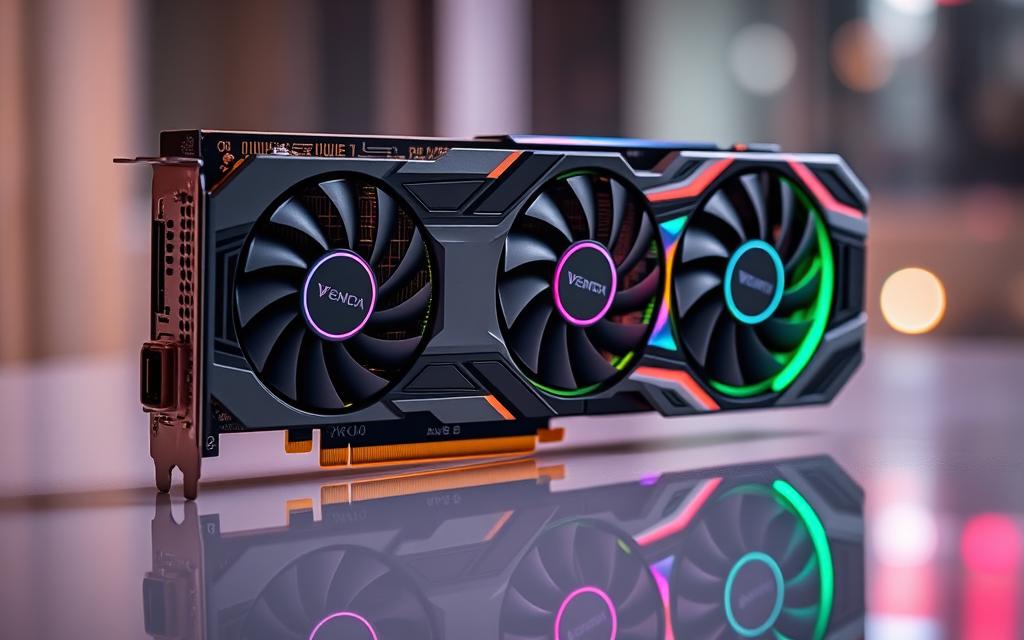
How GPUs Enhance Visuals
Modern GPUs like the RTX 40-series and AMD RX 7000 series bring games to life with advanced features. Ray tracing simulates realistic lighting, while DLSS (Deep Learning Super Sampling) boosts frame rates without sacrificing quality. These technologies ensure every detail, from shadows to reflections, looks stunning.
For texture-heavy games like Hogwarts Legacy, a minimum of 12GB VRAM is essential. This ensures smooth rendering of complex environments and high-resolution textures. Balancing these features with other components is key to maximizing performance.
Best GPUs for Different Budgets
Choosing the right graphics card depends on your budget and gaming needs. Here’s a breakdown of top options:
- Nvidia RTX 4070 ($600): Ideal for 1440p gaming, offering excellent value and performance.
- AMD RX 7900 XT ($900): A high-end choice for 4K gaming, delivering unmatched visuals.
- RTX 3060 (Under $400): Perfect for 1080p gaming, providing a budget-friendly yet powerful solution.
The global chip shortage has impacted GPU pricing, making some models more expensive. However, investing in a quality graphics card ensures your system stays relevant for years. For more insights on pairing your GPU with the right CPU, check out this guide.
RAM: Ensuring Smooth Gameplay
RAM plays a critical role in delivering seamless gaming experiences. It acts as temporary storage for active applications, ensuring quick access to data. Without sufficient memory, even the most powerful systems can struggle with lag and stuttering.
How Much RAM Do You Need?
For modern titles, 16GB is the minimum requirement. This ensures smooth multitasking and reduces bottlenecks during intense sessions. However, content creators and streamers should consider 32GB kits for added flexibility.
Dual-channel configurations, where two sticks of RAM work together, can further enhance performance. This setup increases bandwidth, allowing for faster data transfer between the memory and other components.
DDR4 vs. DDR5: What’s the Difference?
DDR5 offers up to 50% faster speeds compared to DDR4, with base frequencies starting at 4800MHz. This makes it ideal for future-proofing your system. However, DDR4 remains a cost-effective option, with 3200MHz being a popular choice for budget builds.
Latency is another factor to consider. DDR4 typically has lower latency (CL16), while DDR5 can range up to CL40. Despite higher latency, DDR5’s increased bandwidth often compensates for this difference.
- Upgrade Paths: Existing systems can often support DDR4, but upgrading to DDR5 may require a new motherboard.
- Performance Metrics: DDR5 excels in bandwidth-intensive tasks, while DDR4 remains reliable for everyday gaming.
- Future-Proofing: Investing in DDR5 ensures compatibility with upcoming technologies.
Storage Solutions for Gamers
Efficient storage solutions are essential for modern gaming setups. The right drive ensures quick access to game data, reducing load times and enhancing overall performance. With modern games like Call of Duty requiring over 200GB of space, choosing the right setup is crucial.
SSD vs. HDD: Which is Better?
When it comes to storage, SSDs and HDDs serve different purposes. SSDs, especially NVMe models, offer blazing-fast speeds of over 3,500MB/s. This makes them ideal for reducing load times. For example, while an HDD might take 60 seconds to load a game, a SATA SSD cuts it to 25 seconds, and an NVMe SSD slashes it to just 8 seconds.
HDDs, on the other hand, provide cost-effective space for larger files. A hybrid setup, like pairing a 1TB NVMe SSD with a 2TB HDD, offers the best of both worlds. This combination ensures fast access to frequently used files while providing ample storage for less demanding data.
How Much Storage Do You Need?
The amount of storage you need depends on your gaming habits. For casual players, 1TB might suffice. However, enthusiasts who play multiple AAA titles should consider 2TB or more. Games like Call of Duty and Red Dead Redemption 2 can easily consume hundreds of gigabytes.
PCIe 4.0 and 5.0 interfaces further enhance SSD performance, making them future-proof options. Additionally, SSD endurance ratings, measured in TBW (Terabytes Written), ensure longevity. For those needing extra space, external drives and NAS (Network Attached Storage) systems provide flexible expansion options.
“The right storage setup can transform your gaming experience, ensuring faster load times and smoother gameplay.”
- Load Times: HDD (60s) vs SATA SSD (25s) vs NVMe (8s).
- Hybrid Setup: 1TB NVMe + 2TB HDD for optimal performance.
- Future-Proofing: PCIe 4.0 and 5.0 interfaces for faster speeds.
- Endurance: SSD TBW ratings for long-term reliability.
- Expansion: External drives and NAS for additional space.
Cooling Systems: Keeping Your PC at Optimal Temperatures
Effective temperature management is vital for maintaining gaming rig performance. Overheating can lead to reduced efficiency, hardware damage, and even system crashes. Investing in the right cooling solutions ensures your components run smoothly during intense gaming sessions.
Types of Cooling Systems
There are two primary cooling methods: air and liquid. Air coolers, like the Noctua NH-D15, use fans to dissipate heat from the CPU. They’re cost-effective and reliable but may struggle with extreme loads. Liquid coolers, such as the NZXT Kraken, use coolant to absorb and transfer heat away from critical parts. These systems can reduce temperatures by 15-20°C compared to air cooling.
All-in-One (AIO) liquid coolers are popular for their ease of installation and efficiency. They’re ideal for high-performance builds where heat generation is significant. However, air coolers remain a solid choice for budget-conscious gamers.
Why Cooling is Crucial for Gaming PCs
Cooling prevents thermal throttling, a process where the CPU or GPU reduces power to avoid overheating. This ensures consistent performance during demanding tasks. Proper airflow optimization, like using case fans and strategic component placement, further enhances cooling efficiency.
Applying thermal paste correctly is another key factor. It fills microscopic gaps between the CPU and cooler, improving heat transfer. Modern cooling solutions also integrate RGB lighting, adding aesthetic appeal without compromising functionality.
“A well-cooled system not only performs better but also lasts longer, protecting your investment.”
- Air Coolers: Affordable and reliable, ideal for moderate setups.
- Liquid Coolers: Efficient and stylish, perfect for high-end builds.
- Thermal Paste: Ensures optimal heat transfer between components.
- Case Airflow: Strategic fan placement maximizes cooling efficiency.
- RGB Integration: Combines functionality with visual appeal.
| Cooling Type | Pros | Cons |
|---|---|---|
| Air Cooling | Cost-effective, easy to install | Less efficient for extreme loads |
| Liquid Cooling | Superior cooling, quieter operation | Higher cost, more complex installation |
Power Supply Units (PSU): Ensuring Stable Performance
A reliable power supply unit (PSU) is the unsung hero of any high-performance gaming setup. It ensures all components receive consistent energy, preventing crashes and hardware damage. Choosing the right PSU is critical for maintaining system stability and longevity.
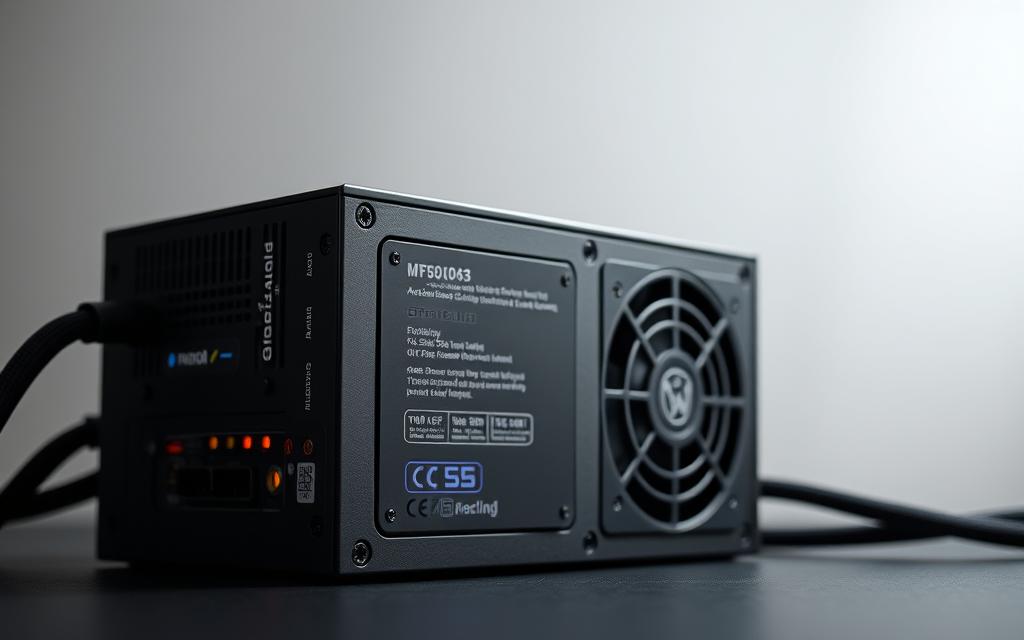
How to Choose the Right PSU
When selecting a PSU, consider its wattage, efficiency, and design. High-end builds, like those featuring an RTX 4080, require at least 750W. Modular PSUs offer flexibility by allowing you to connect only the cables you need, reducing clutter and improving airflow.
Non-modular PSUs are more affordable but come with fixed cables, which can make cable management challenging. Additionally, look for features like power spike protection, which safeguards your components during sudden voltage fluctuations.
Wattage and Efficiency Considerations
Calculating your system’s total power consumption is essential. Online wattage calculators can help determine the minimum wattage required. For example, a build with an RTX 4080 and an i7 processor typically needs an 850W PSU.
Efficiency ratings, like 80 Plus Gold, indicate how effectively the PSU converts AC power to DC. Higher ratings reduce energy waste and lower operating costs. The Corsair RM850x is a top choice for high-end builds, offering 80 Plus Gold certification and a 10-year warranty.
“A quality PSU not only powers your system but also protects your investment from unexpected failures.”
- Modular vs. Non-Modular: Modular PSUs offer better cable management, while non-modular units are more budget-friendly.
- Power Spike Protection: Ensures your components remain safe during voltage fluctuations.
- Wattage Calculators: Use online tools to determine your system’s power needs.
- Lifespan: Look for PSUs with long warranties, like the Corsair RM850x’s 10-year coverage.
Motherboards: The Backbone of Your Gaming PC
The motherboard is the central hub connecting all your gaming rig’s components. It ensures seamless communication between the CPU, GPU, RAM, and storage. Without a high-quality motherboard, even the best hardware can’t perform at its peak.
Key Features to Look For
When choosing a motherboard, consider its form factor. ATX boards offer more expansion slots, while micro-ATX is compact and cost-effective. PCIe 5.0 lanes are essential for future-proofing, providing faster data transfer for GPUs and SSDs.
USB-C 3.2 Gen 2×2 ports are another critical feature. They deliver speeds up to 20Gbps, ideal for high-speed peripherals. BIOS flashback allows you to update the firmware without a compatible CPU, ensuring compatibility with newer processors.
Compatibility with Other Components
Ensure your motherboard matches your CPU’s socket type. Intel’s LGA 1700 supports 12th and 13th Gen processors, while AMD’s AM5 is designed for Ryzen 7000 series. The MSI MPG Z790 Edge WiFi is a top choice for Intel builds, offering robust features and reliable performance.
“A well-chosen motherboard ensures your system runs smoothly, maximizing the potential of every component.”
- Form Factors: ATX for expansion, micro-ATX for compact builds.
- PCIe 5.0: Future-proof your system with faster lanes.
- USB-C 3.2 Gen 2×2: High-speed connectivity for modern peripherals.
- BIOS Flashback: Update firmware without a compatible CPU.
- Recommended: MSI MPG Z790 Edge WiFi for Intel builds.
Pre-Built vs. Custom Gaming PCs
Choosing between pre-built and custom gaming PCs can shape your entire experience. Each option has its strengths and weaknesses, depending on your needs and budget. Whether you’re buying gaming rigs or building your own, understanding the differences is crucial.
Pros and Cons of Pre-Built PCs
Pre-built gaming pcs offer convenience and instant setup. They’re ideal for those who want a ready-to-use system without the hassle of assembly. However, they often cost 15-20% more than DIY builds. This premium includes warranties and technical support, which can be valuable for beginners.
One downside is OEM bloatware, which can slow down your system. Branded systems may also limit upgrades due to proprietary components. For example, some pre-builts use custom motherboards or power supplies, making it harder to swap out parts later.
Premium brands like Origin PC and Maingear stand out for their high-quality builds and customization options. These gaming pcs cater to enthusiasts who want top-tier performance without the DIY effort.
Building Your Own Gaming PC: Is It Worth It?
Building your own PC gives you full control over every component. You can tailor the system to your exact needs, ensuring no compromises. While it takes about 4 hours to assemble, the process can be rewarding and educational.
DIY builds are also more cost-effective. You avoid the markup on pre-builts and can choose parts that fit your budget. However, you’ll need tools like an anti-static wristband and thermal paste to ensure a smooth build.
Here’s a quick checklist for DIY builders:
- Anti-static wristband
- Thermal paste
- Screwdrivers (Phillips and flathead)
- Cable ties for management
| Feature | Pre-Built PCs | Custom PCs |
|---|---|---|
| Cost | 15-20% higher | More affordable |
| Setup Time | Instant | 4 hours (approx.) |
| Upgrade Flexibility | Limited | Full control |
| Warranty | Included | Component-specific |
“Whether you choose pre-built or custom, the right decision depends on your priorities—convenience or customization.”
Budget Considerations for Gaming PCs
Building a gaming setup that fits your budget requires careful planning and smart choices. Whether you’re aiming for an entry-level rig or a high-end enthusiast build, understanding your financial limits is key. Balancing cost and performance ensures you get the most out of your investment.
What to Expect at Different Price Points
At the $800 mark, you can build a solid entry-level PC capable of 1080p gaming. Focus on allocating 40% of your budget to the GPU, 20% to the CPU, and the rest to RAM, storage, and other components. For 1440p gaming, a $1,500-$2,000 build is ideal, with a stronger emphasis on the GPU and cooling systems.
Enthusiast builds, starting at $3,500, are designed for 4K gaming and future-proofing. These systems prioritize top-tier components like the RTX 4090 and Ryzen 9 processors. However, you can still achieve excellent value by shopping during seasonal sales like Black Friday or exploring the used market for deals on GPUs.
How to Get the Best Value for Your Money
Maximizing your budget involves strategic planning. Here are some tips:
- Component Allocation: Spend 40% on the GPU, 20% on the CPU, 15% on RAM, 10% on storage, and the rest on cooling and peripherals.
- Seasonal Sales: Black Friday and Cyber Monday often feature significant discounts on GPUs and SSDs.
- Used Market: Platforms like eBay can offer great deals on slightly older GPUs, such as the RTX 3080.
- Cost-Cutting: Skip RGB lighting and reuse peripherals like monitors and keyboards to save money.
“A well-planned budget ensures you get the most out of your gaming investment without compromising on quality.”
| Price Point | Best For | Key Components |
|---|---|---|
| $800 | 1080p Gaming | RTX 3060, Ryzen 5 5600X, 16GB RAM |
| $1,500-$2,000 | 1440p Gaming | RTX 4070, i7-13700K, 32GB RAM |
| $3,500+ | 4K Gaming | RTX 4090, Ryzen 9 7950X, 64GB RAM |
By carefully allocating your budget and taking advantage of sales and used market opportunities, you can build a gaming PC that delivers exceptional performance without overspending.
Additional Peripherals for Gaming
Enhancing your gaming setup goes beyond the core components. Peripherals like monitors, keyboards, mice, and headsets play a crucial role in delivering an immersive gaming experience. Choosing the right accessories can elevate your gameplay, making every session more enjoyable and responsive.
Monitors: Choosing the Right Display
A high-quality monitor is essential for any gaming setup. The display directly impacts how you experience games, from visual clarity to responsiveness. For competitive gaming, a minimum refresh rate of 144Hz is recommended to ensure smooth motion and reduce input lag.
When selecting a monitor, consider panel technologies like IPS and VA. IPS panels offer better color accuracy and viewing angles, making them ideal for vibrant visuals. VA panels, on the other hand, provide deeper contrast ratios, which are great for darker scenes in games.
Compatibility with adaptive sync technologies like G-Sync and FreeSync is another key factor. These features eliminate screen tearing and stuttering, ensuring a seamless gaming experience. For example, the LG UltraGear 34GP950G-B supports G-Sync Ultimate, making it a top choice for enthusiasts.
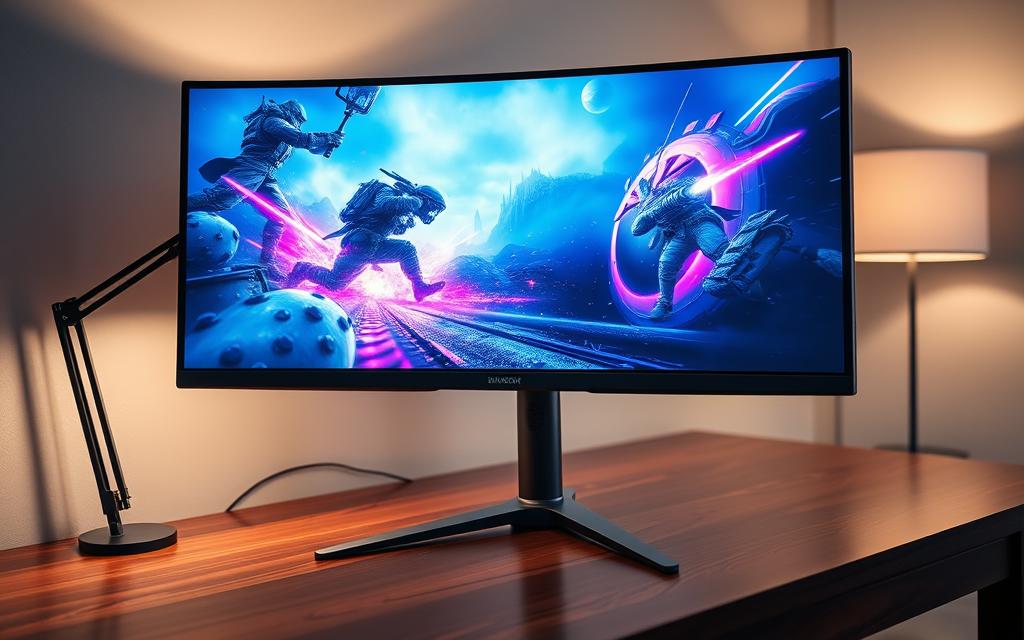
Keyboards, Mice, and Headsets: Enhancing Your Setup
Your choice of keyboard and mouse can significantly impact your performance. Mechanical keyboards, like the Razer BlackWidow V4 Pro, offer customizable RGB lighting and dedicated macro buttons. Switch types, such as Cherry MX and Razer Yellow, cater to different preferences, whether you prioritize speed or tactile feedback.
For precision and comfort, the Logitech G Pro X Superlight wireless mouse is a standout option. Its lightweight design and high DPI settings make it perfect for fast-paced games. Similarly, the Asus ROG Keris II Ace offers wireless and wired connectivity, ensuring flexibility for any setup.
Audio quality is equally important. Headsets like the SteelSeries Arctis Nova Pro Wireless deliver audiophile-grade sound with 40mm Neodymium drivers. For those who prefer earbuds, the Razer Hammerhead Pro HyperSpeed provides ANC and customizable EQ settings, enhancing your gaming experience.
For more insights on the best gaming accessories, check out this comprehensive guide.
| Feature | IPS Panels | VA Panels |
|---|---|---|
| Color Accuracy | Excellent | Good |
| Contrast Ratio | Moderate | High |
| Viewing Angles | Wide | Narrow |
| Best For | Vibrant visuals | Darker scenes |
Optimizing Your Gaming PC for Performance
Fine-tuning your setup can unlock hidden performance boosts. Beyond hardware, software tweaks and advanced techniques like overclocking can elevate your gaming experience. These adjustments ensure smoother gameplay, faster load times, and extended hardware longevity.
Software Tweaks and Updates
Start by updating your drivers and operating system. Outdated software can bottleneck your system, reducing efficiency. Tools like MSI Afterburner allow you to fine-tune your GPU’s voltage curve, optimizing power consumption and processing speed.
Activating XMP profiles in your BIOS can enhance RAM performance. This feature unlocks your memory’s full potential, ensuring faster data transfer. Additionally, enabling CPU turbo boosting in BIOS settings can provide a noticeable speed increase for demanding tasks.
Overclocking: Risks and Rewards
Overclocking your GPU or CPU can yield 10-15% FPS gains, but it comes with risks. Pushing your hardware beyond factory limits increases heat and power consumption. Use stress testing tools like Prime95 and 3DMark to ensure stability.
However, overclocking voids most warranties. If you’re new to this, start with conservative adjustments and monitor temperatures closely. Proper cooling is essential to prevent thermal throttling or hardware damage.
“Overclocking is a powerful tool, but it requires caution and precision to avoid compromising your system.”
- MSI Afterburner: Fine-tune GPU voltage curves for optimal performance.
- XMP Profiles: Unlock your RAM’s full potential with a single BIOS setting.
- Stress Testing: Use Prime95 and 3DMark to ensure system stability.
- Warranty Risks: Overclocking may void your hardware warranty.
- Cooling: Ensure proper airflow to handle increased heat output.
By combining software optimizations and careful overclocking, you can maximize your gaming rig’s capabilities. Always prioritize stability and monitor your system to avoid long-term damage.
Future-Proofing Your Gaming PC
Investing in the right components today can save you from costly upgrades tomorrow. Future-proofing your gaming setup ensures it remains relevant for years, even as technology advances. By focusing on key areas like GPU cycles, socket compatibility, and modular designs, you can build a system that stands the test of time.
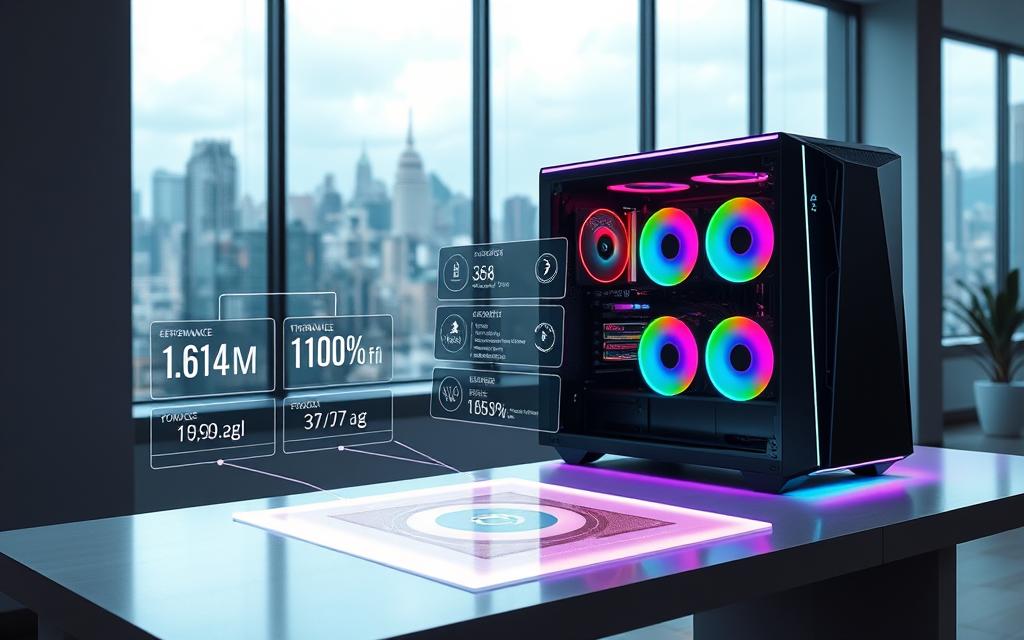
How to Ensure Longevity
Modern gaming pcs require a balance of performance and adaptability. Start with a GPU that supports the latest technologies, like the RTX 4070 or better. These cards are designed to handle upcoming titles with ease, ensuring high FPS and stunning visuals for years.
Socket compatibility is another critical factor. AMD’s AM5 platform, for example, will remain relevant until 2025, offering support for PCIe 5.0 and DDR5 memory. This ensures your system can accommodate future CPUs and hardware upgrades without needing a new motherboard.
Upgrading Components Over Time
Upgrading your system doesn’t have to be overwhelming. Focus on modular case designs that allow easy access to components. This makes swapping out parts like GPUs, RAM, and storage straightforward, saving you time and effort.
Multi-GPU setups are becoming less common, so prioritize a single powerful GPU. Additionally, consider cloud gaming’s impact. While it reduces the need for high-end local hardware, having a robust system ensures you’re prepared for any gaming scenario.
“Future-proofing isn’t just about buying the latest tech; it’s about making smart, upgradable choices.”
| Component | Recommendation | Reason |
|---|---|---|
| GPU | RTX 4070 or better | Supports future titles and technologies |
| CPU Socket | AM5 (until 2025) | Ensures compatibility with next-gen CPUs |
| Case | Modular design | Simplifies upgrades and maintenance |
For more insights on building a future-ready gaming PC, check out this comprehensive guide.
Conclusion
Building a gaming setup that delivers exceptional performance starts with understanding the core components. A balanced system ensures smooth gameplay and prevents bottlenecks. Focus on the five pillars: GPU, CPU, RAM, storage, and cooling. Prioritize harmony over individual premium parts for the best gaming experience.
For first-time builders, start with a mid-range setup and upgrade over time. This phased approach helps manage your budget while keeping your system relevant. Look for deals on components during seasonal sales to maximize value.
Share your setup and explore community recommendations for further optimization. Whether you’re playing competitive games or enjoying immersive worlds, the right balance of components ensures a seamless gaming experience.
FAQ
Why is the CPU important for gaming?
The processor (CPU) handles game logic, physics, and AI. A powerful CPU, like the Intel Core i9 or AMD Ryzen 9, ensures smooth performance in demanding games.
How does a GPU improve gaming visuals?
A high-end graphics card, such as the NVIDIA RTX 4090 or AMD RX 7900 XT, delivers realistic textures, ray tracing, and high frame rates for immersive gameplay.
How much RAM is ideal for gaming?
16GB is the sweet spot for most games, but 32GB future-proofs your system for titles like Cyberpunk 2077 or Starfield.
Should I choose an SSD or HDD for storage?
SSDs, like the Samsung 980 Pro, load games faster than HDDs. A 1TB SSD provides ample space for modern AAA titles.
Why is cooling critical for gaming PCs?
Proper cooling, whether air (Noctua NH-D15) or liquid (Corsair iCUE H150i), prevents thermal throttling and extends the lifespan of components.
What wattage PSU do I need?
A 750W–850W PSU (e.g., Corsair RM850x) supports high-end GPUs and CPUs while maintaining efficiency.
Are pre-built gaming PCs worth it?
Pre-built systems from brands like Alienware or ASUS ROG offer convenience, but custom builds often provide better value and upgradability.
How do I future-proof my gaming PC?
Invest in a motherboard with PCIe 5.0 (e.g., ASUS ROG Maximus Z790) and upgradeable components like DDR5 RAM.
What’s the best monitor for gaming?
A 144Hz–240Hz display (like the LG UltraGear 27GP850) with 1440p resolution balances speed and visual clarity.
Is overclocking safe for gaming performance?
Overclocking can boost FPS but requires quality cooling and a stable PSU to avoid hardware damage.


